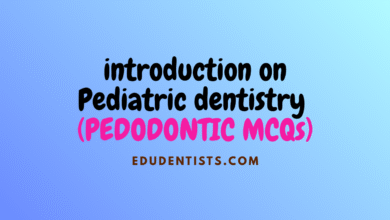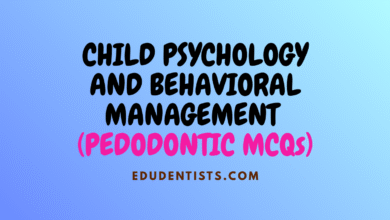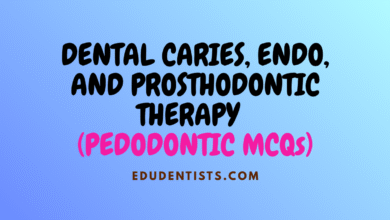Pedodontics MCQs
Growth and Development MCQs _ Pediatric Dentistry MCQs

Growth and Development MCQs _ Pediatric Dentistry MCQs
- Infancy and childhood are dynamic periods of:
A. Dentition
B. Growth and development
C. Head and face
D. Habits - Developmental milestone provide a framework for observing and monitoring:
A. Child
B. Elderly persons
C. None of the above
D. All of the above - What play a role in development of children:
A. Parent and sibling personalities
B. Family socioeconomic status
C. Caregivers nurturing methods
D. None of the above - Primitive reflexes develop and persists for several months after:
A. Birth
B. Death
C. None of the above
D. All of the above - Reflexes enables the infant to make purposeful:
A. Movements
B. Support
C. Development
D. None of the above - Equilibrium in infants begin for walking by:
A. 6 months
B. 2 months
C. 4 months
D. 12 months - Additional equilibrium responses develop during:
A. 2nd year
B. 4th year
C. None of the above
D. All of the above - In infants movement of hands and feet is dominated by:
A. Primitive grasp reflex
B. Firm grasp
C. None of the above
D. All of the above - Palmar grasp develops in which age:
A. 7 months
B. 2 months
C. 4 months
D. None of the above - Pincer grasp develops in which age:
A. 4 months
B. 5 months
C. 9 months
D. 12 months - Bidextrous grasp develops in which age:
A. 8 months
B. 5 months
C. 12 months
D. None of the above - Radial digital grasp develops in:
A. 9 months
B. 1 year
C. 2 years
D. None of the above - Scissors grasp develops in:
A. 10 months
B. 8 months
C. 12 months
D. None of the above - Voluntary release in infants develops at:
A. 5 months
B. 15 months
C. 6 months
D. 7 months - Skills develop in which direction:
A. Cephalic to caudal
B. Caudal to cephalic
C. Caudal
D. None of the above - Skills progress from which end:
A. Proximal to distal
B. Proximal to anterior
C. Anterior to posterior
D. None of the above - Genetic theory of growth was given by:
A. Brodie
B. Scott
C. Sicher
D. None of the above - Sutural dominance theory was given by:
A. Scott
B. Sicher
C. Moss
D. None of the above - Cybernetics theory was given by:
A. Petrovic
B. Brodie
C. Moss
D. None of the above - Stewart gave theory of growth in:
A. 1986
B. 1982
C. 1988
D. 1931 - Scott hypothesis of growth determines growth of:
A. Cartilage
B. Bone
C. None of the above
D. All of the above - Sutural dominance theory is also known as:
A. Moss hypothesis
B. Sichers hypothesis
C. Cartilaginous theory
D. All of the above - In sutural dominance theory if sutures are compressed then growth:
A. Impedes
B. No effect
C. None of the above
D. All of the above - van Limborg concept of growth was given in:
A. 1970
B. 1988
C. 1999
D. None of the above - Cybernetics is science dealing with study of complex computers of human:
A. Nervous system
B. Digestive system
C. None of the above
D. All of the above - Genetic theory by Brodie states that genes control all functions of:
A. Growth and development
B. Growth but not development
C. Neither growth nor development
D. None of the above - Greatest amount of cranial growth occurs by:
A. Birth to five years
B. 5–6 years
C. 6–7 years
D. 7–9 years - At birth which of the following structures is nearest the size it will eventually attain in adulthood
A. Cranium
B. Mandible
C. Middle face
D. Nasal capsule - Epigenetic factors controlling the growth of skeleton are:
A. Genetic factors present within skeleton
B. Genetic factors present outside skeleton
C. Local genetic factors
D. General non-genetic factors - Meckels cartilage give rise to:
A. Condylar process
B. Coronoid process
C. Rest of ramus
D. None of the above - Which of the following shows 200% growth the adult size from 9 to 10 years?
A. Neural
B. General
C. Lymphoid
D. Muscle - If a child’s teeth do not form, this will afect the growth of:
A. Maxilla
B. Mandible
C. Whole face
D. Alveolar bone - After the age of six the increase in the size of the mandible occurs at:
A. Symphysis
B. Between canines
C. Along the lower border
D. Distal to 1st molar - Growth of maxilla in the vertical direction is due to:
A. Growth of alveolus
B. Growth of sutures
C. Growth of cranial base
D. Growth of synchondrosis - Growth of cranium continues upto:
A. 2 years
B. 10 years
C. 15 years
D. Grows equally - Earlier closure of a suture is called:
A. Synchondrosis
B. Synostosis
C. Ankylosis
D. Epiphysis - The functional matrix concept as revised by Moss does not include:
A. Connected cellular network
B. Mechano transduction
C. Epigenetic epithesis
D. None of the above - Enlow’s “v” concept of growth is found in:
A. Cranial base
B. Maxilla only
C. Maxilla and mandible
D. None of the above - Oral and nasal capsule of functional growth related to:
A. Periosteal matrix
B. Sutural matrix
C. Capsular matrix
D. None of the above - In Sicher’s theory, suture acts as:
A. Has independent growth potential
B. Dependant on cranial base
C. Used for growth adjustment
D. None of the above - Mechanism of bone growth is by:
A. Bone deposition and resorption
B. Cortical drift
C. Displacement
D. All of the above - Functional matrix theory suggests that the determinant growth of skeletal tissue resides in:
A. Skeletal
B. Sutures
C. Cartilages
D. Non-skeletal tissues - Growth sites in maxilla are:
A. Maxillary tuberosity
B. Sutures
C. Nasal septum
D. All of the above - Mandible develops from:
A. Meckels cartilage
B. Ramus
C. None of the above
D. Both of the above - Maxilla develops by:
A. Endochondral bone formation
B. Intramembranous bone formation
C. Cartilage replacement and intramembranous bone formation
D. Mostly cartilage replacement and a little by intramembranous - Meckels cartilage gives rise to:
A. Condylar process
B. Coronoid process
C. Rest of ramus
D. None of the above - Which secondary cartilage help in development of maxilla?
A. Malar cartilage
B. Meckels cartilage
C. Both of the above
D. None of the above - Growth of oral structures is mainly infuenced by factors:
A. Hereditary
B. Environmental
C. Hereditary influenced by environmental
D. None of the above - Postnatal development of mandible is based on:
A. Enlow’s principle
B. V principle
C. None of the above
D. All of the above - Postnatal growth of maxilla is by:
A. Primary displacement
B. Primary and secondary displacement
C. Secondary displacement
D. None of the above - Spermatid transforms into sperm by process by:
A. Spermatogenesis
B. Spermiogenesis
C. Oogenesis
D. None of the above - The stage happens three days after fertilization when embryo is about to enter uterus , zygote at this stage is called:
A. Morula
B. Oogonia
C. None of the above
D. Both of the above - Development of primitive streak forms:
A. Mesoderm
B. Endoderm
C. Ectoderm
D. None of the above - Bilateral localized thickenings appear over ectoderm overlying frontonasal process called:
A. Nasal placodes
B. Lens placodes
C. None of the above
D. Both of the above - Lateral part of upper lip is formed by:
A. Mandibular process
B. Maxillary process
C. Frontonasal process
D. None of the above - Median part of upper lip is formed by:
A. Maxillary process
B. Frontonasal process
C. Mandibular process
D. None of the above - Stomatodeum is the future:
A. Lip
B. Mouth
C. Teeth
D. None of the above - Tuberculum impar contribute to formation of:
A. Palate
B. Tongue
C. Lips
D. None of the above - Medial nasal process and frontonasal process gives rise to:
A. Primary palate
B. Secondary palate
C. None of the above
D. Both of the above - Growth varies with seasons , it is faster in:
A. Springs
B. Winter
C. Autumn
D. All of the above - Cephalocaudal gradient of growth extends from:
A. From feet to head
B. From head to feet
C. Both of the above
D. None of the above - Most reliable method of skeletal age assessment is:
A. Hand wrist radiograph
B. Bitewing radiograph
C. None of the above
D. All of the above - The timing of growth spurts for boys in mixed dentition:
A. 7 to 9 years
B. 8 to 11 years
C. 9 to 12 years
D. None of the above - The timing of growth spurts for girls in mixed dentition:
A. 7 to 9 years
B. 8 to 11 years
C.9 to 12 years
D. None of the above - Adolescent growth spurts for boys:
A. 11 to 13 years
B. 14 to 16 years
C. 10 to 12 years
D. None of the above - Adolescent growth spurts for girls:
A. 11 to 13 years
B. 14 to 16 years
C. 10 to 12 years
D. None of the above - The term growth trends is given by:
A. Scammon
B. Tweed
C. Sheldon
D. Bjork - Scammon’s growth curve. False is:
A. Neural tissues _ most of the growth is completed by 6 years
B. Lymphoid tissues _ growth reaches 200% by age 13 and regresses afterwards
C. Genital tissues _ most of growth is completed by age of puberty
D. None of the above - The normal value of ANB angle is:
A. 4°
B. 2°
C. 6°
D. None - The technique for diagnosis and treatment planning for growth and development:
A. VTO
B. VTA
C. Both of the above
D. None of the above - If ANB angle is less than 2° this indicates:
A. Class 2 malocclusion
B. Class 3 malocclusion
C. Both of the above
D. None of the above - The growth of neural tissues is nearly complete by:
A. 12–14 years of age
B. 9–12 years of age
C. 6–7 years of age
D. 2–3 years of age - The type of tissue which proliferate far beyond the adult amount in childhood, and then undergo involution is:
A. Lymphoid tissue
B. Neural tissue
C. General tissue
D. Genital tissue - The type of tissue that shows a s-shaped growth curve is:
A. Lymphoid tissue
B. Neural tissue
C. General tissue
D. All of the above - The head occupies:
A. Almost 50% of the total body length at 3rd month of intrauterine life
B. Almost 30% of the total body length at birth
C. Almost 12 % of the total body length of the adult
D. All of the above - Vital staining done to study the skeletal growth was introduced by:
A. Ten Cate
B. Scammon
C. Belchier
D. John Hunter - Stain used for vital staining of skeletal tissue is:
A. Eosin
B. Hematoxylin
C. Alizarin
D. All of the above - Hyperplasia of cell refers to increase in the:
A. Size
B. Number
C. Function
D. All of the above - Stages of tooth development can be calculated by:
A. Nolla’s method
B. Demirgian method
C. Ericsson’s method
D. Both (a) and (b) - At birth, which of the following structures is nearest the size it will eventually attain in adulthood:
A. Cranium
B. Mandible
C. Clavicle
D. Middle face - The inter-incisal angle in primary dentition is around:
A. 120°
B. 90°
C. 150°
D. 180° - How is the growth curves of lymphoid tissue and genital tissue related to each other?
A. Both curves follow almost a similar path
B. Lymph tissues stop growing when genital tissues begin growing
C. Lymph tissues regress as genital tissues develop
D. Growth curves of both the tissues are not related to each other - In mandible the main growth site is in the:
A. Gonial angle
B. Inferior alveolar nerve canal
C. Condylar cartilage
D. Posterior border of ramus - Deficiency of which of the following causes neural tube defects like anencephaly and spina bifida:
A. Iron
B. Folic acid
C. Zinc
D. Calcium - With a flush terminal plane, permanent first molars will:
A. Initially be class II
B. Initially be class III
C. Immediately assume a normal relationship
D. Erupt immediately into an end to end relationship - Relative to primary mandibular incisors, permanent mandibular incisors erupt:
A. Lingually
B. Facially
C. Distally
D. Mesially - Six keys to normal occlusion were given by:
A. Andrew
B. Angle
C. Tweed
D. Steiner - Supervision of a child’s development of occlusion is most critical at ages:
A. 3–6 years
B. 7–10 years
C. 11–14 years
D. 14–17 years - The chronological age of the child is calculated by:
A. The maturity of emotions of the child
B. The maturity of bones of the hand and wrist
C. The number of teeth erupted in the oral cavity
D. The birth date - The chronological age of a child is:
A. Closely related to the dental age
B. Closely related to the skeletal age
C. Closely related to the emotional age
D. Independent of the dental and skeletal ages - Sucking reflex develops at:
A. 4th week of intra-uterine life
B. 17th–20th week of intra-uterine life
C. At birth
D. 4th week after birth - Moro’s refex usually disappears by:
A. 2–3 months
B. 6–12 months
C. 3–4 years
D. Remains life long - Parachute reflex appears at about:
A. 2–3 months
B. 6–9 months
C. 1–2 years
D. At birth - The most rapid period of growth is:
A. Puberty
B. 6–8 years
C. 2–3 years
D. 1st year of life - Maxilla is primarily formed by:
A. Intramembranous bone formation
B. From cartilage
C. Endochondral bone formation
D. Equally by intramembranous and endochondral bone - If a child’s teeth do not form, this would primarily effect the growth of:
A. Maxilla
B. Alveolar bone
C. Whole face
D. Mandible - By what age does the Moro reflex disappear?
A. 2–3 months
B. 1 year
C. 24 months
D. 15–18 months - The approximate age at which the child begins to walk is at:
A. 0–2 months
B. 3–6 months
C. 7–8 months
D. 9–12 months - By what age does grasp and startle reflex disappear?
A. 12 months
B. 18 months
C. 24 months
D. 36 months - The most rapid growth in humans occur during:
A. Pre-natal period
B. 6–12 months after birth
C. 3–5 years of life
D. Beginning of teenage years - Negative growth is a characteristic of:
A. Testis
B. Brain
C. Mandible
D. Thymus - The implant method of studying growth was proposed by:
A. Scammon
B. Moss
C. Belchier
D. Bjork - The body tissue that grows rapidly but shows minimal growth after the age of 6–7 years is:
A. Neural tissue
B. Lymphoid tissue
C. Skeletal tissue
D. Genital tissue - The movement of bone in response to its own growth is termed as:
A. Rotation
B. Secondary displacement
C. Primary displacement
D. Replacement shift - Relapses occur most frequently following treatment of:
A. Extrusion
B. Intrusion
C. Rotation
D. Tipping



